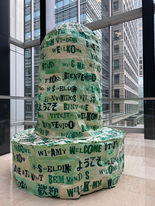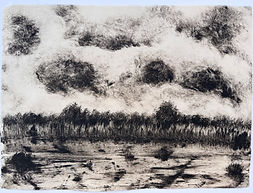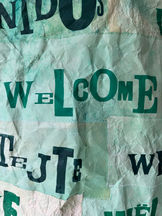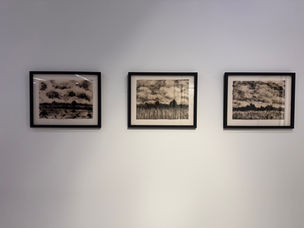Welcome
A Print Installation
Currently installed in the client reception at Clifford Chance,
10 Upper Bank Street, Canary Wharf, London, E14 until late March 2026.
These were made as site specific pieces for the Clifford Chance / UAL Sculpture Award 2025.
This exhibition can be viewed by appointment, please email Nigel.Frank@cliffordchance.com

Jo Boddy Welcome: A Print Installation
In association with the University of the Arts London (UAL), for the last 20 years Clifford Chance has run an annual Sculpture Award, supporting an artist at the launch of their art career to create new work that responds to the particularities of our office, its locality, and the firm's values.
After receiving proposals from the 2024 cohort of UAL students, Clifford Chance selected Jo Boddy to realise our 2025 commission. Her work is both a deep dive into the past and present of Canary Wharf and the River Thames's extensive human and physical impact on the history of the Isle of Dogs, and a multi-varied print investigation. Clifford Chance's own art collection is dedicated to the art of printmaking and Jo's proposal expands the art form, taking it into the 3rd dimension with a collage of print techniques – letterpress, etching, linocut, collagraph and more. Installed alongside the major commissions are a selection of monoprints, illustrative of her start point in the development of her sculptural ideas.
Since winning the commission, Jo has undertaken extensive research prior to making the works: into the art of letterpress printmaking, field trips to explore the distinctive ecology of the Thames and its banks, the history of the Isle of Dogs from its initial Roman settlement, through its agricultural usage prior to the development of the docks and on to its current incarnation as a centre of international financial services. With divertissements into the typology of nautical buoys (it helps that Jo was, and continues to be, a keen sailor) and the challenges of language transcriptions. This knowledge imbues the work.
Buoys, still visible on the waterways around the Wharf, are internationally recognised signals that determine direction and safe movement. Boddy's Welcome Buoy, standing at the head of the escalators, is symbolically coloured green to guide visitors, passing to its left to reach reception. Its skin a covering of letterpress and calligraphic signs of welcome, representing the predominant language of the locations of each of our international offices. The large wall collage represents a map of the sweep on the Thames as it wraps around the Isle of Dogs. Its course a stream of blue toned prints of schematic office towers and hi-rise blocks. The river is now, as always, plugged into an international network of exchange; previously goods and peoples, now information. Surrounding the river, a subtle colour variation depicts a landscape that moves, lower to upper, south to north, from the marshy margins of the river, through its banks and into fields of cultivation. Individual prints illustrate the flora and fauna of the region; bird tracks and flower seeds. Flanking the collage, on the adjacent columns is a printed grid structure that mimics the industrial cranes that transformed this area made of the wood that once grew here before humans settled this land.
The Clifford Chance Art committee's thanks are due to Jo for her dedication and resolution in realising this ambitious project, her bravery in exploring new artistic territory in such a public forum, and for allowing us the opportunity to display these works for six months in our client reception. They will be enjoyed by all who work and visit our office.
Nigel Frank
Clifford Chance Art Collection


‘Welcome Buoy’
2025
Letterpress and linocut on dyed & treated Kitakata 60gsm, Fabriano Rosaspina 285gsm and Somerset Satin 250gsm, machine stitch, papier mâché, wood, cardboard, chicken wire, wire.
Approx 1.5m x 2.2m
For millennia the River Thames was the main route into and out of London, it is the reason London is both where and what it is. Channel markers had been used for centuries before Henry VIII established Trinity House in 1514 to manage navigational aids in English waters. This is a starboard lateral marker; you leave it on your right as you enter port or head upstream. ‘Welcome’ is printed in letterpress and linocut in languages spoken in Clifford Chance offices around the world. The buoy being placed here in Canary Wharf reflects not just the current nature of global business conducted here but reminds us that this is the site of docks, first opened in 1802, an entry point for both goods and people from around the world.
The word ‘Welcome’ is often placed at points of entry; how conditional is that welcome?
‘Where Fortunes Flow and Mud Remembers’
2025
Collage of linocut, etching, collagraph, etched lino, monoprint, letterpress, direct mud print, Suminagashi marbling, chine collé, drypoint & viscosity print on various papers with stitch, all on Fabriano Accademia 120gsm
Approx. 5m x 2.6m
The River Thames is the reason for London. Incalculable wealth has flowed in and out of the city via the Thames. The first docks on the Isle of Dogs opened in 1802, built on land that was marsh and animal grazing. At some point, likely prior to the neolithic period, there would have been trees, humans cleared these too. This collage takes the most human of communication tools, written letters and numbers, and turns them into the skyscrapers that now stand where once there were warehouses and cranes (if you look closely, you can see a hint of these). Humans have changed the land beyond recognition, but underneath, in the mud, the evidence of what was remains.
In the long history of London, the Isle of Dogs seems a recent addition to its built environment and yet we have been using this land, altering it and shaping it to our own ends since human settlement in Britain began. It just seemed less obvious when there were more birds.


Welcome
Montgomery Square
2025
Letterpress & Suminagashi Marbling on BFK Rives 280gsm
56x77cm paper size
These two prints were made intuitively whilst working on the welcome imagery for the buoy and the skyscraper imagery for the River Thames. People and goods arriving and the question of exactly who and what is welcome and on what terms is a question as old as humanity, I'm sure. The idea of taking the word welcome and distorting it played into the idea of a distorted and possibly insincere welcome.
Montgomery Square made itself due to the nature of letterpress chases and the way they were arranged on the press bed. I noticed how the format seemed to be echoing skyscrapers arranged around an open square and so purposely arranged the chases to echo this without trying to fill the edges or the middle of the paper. Suminagashi marbling was added to both prints to reflect the watery theme of the Thames as well as being reminiscent of contour lines on a map reflecting the mapping of land over time.



Isle of Dogs c.1775: Imagined Marsh
Isle of Dogs c.1775: Imagined Grasses
Isle of Dogs c.1775: Imagined Grazing
2025
Monoprint on Kitakata 60gsm
39x27.5cm paper size
These three monoprints came out of experimenting with imagery researched along the Thames estuary, Thames wetlands and Norfolk Broads to build up a picture of what the Isle of Dogs might have looked like prior to the docks being built. The land is described as being marshy but also used for animal grazing. Big skies and the feeling of being windswept became recurring themes.


























